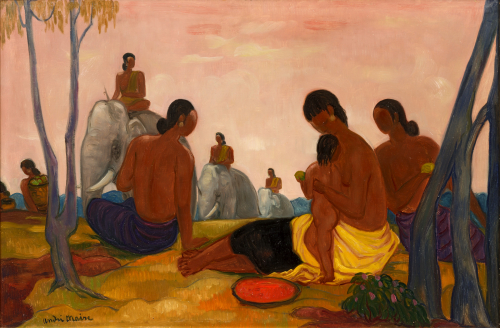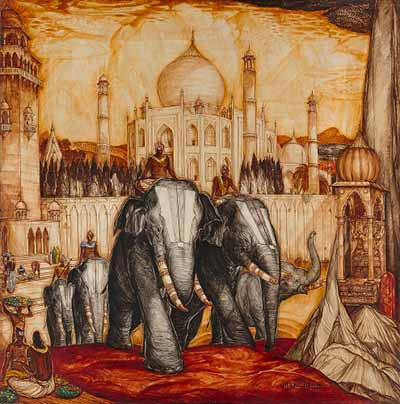
" Voyages D’André MAIRE " at the Regards de Provence museum
André Maire, a French painter in the ruins of Angkor in 1920
From December 16, 2017 to May 27, 2018, the Regards de Provence Museum honors the painter and draftsman André Maire (1898-1984), an insatiable traveler whose prolific work accounts for nearly a century of peregrinations to the four corners of the globe.
At the dawn of the 1920s, André Maire approached the Indochinese shores. In love with adventure, he is an enthusiastic young man who sets off for the distant colonies, during his military service, eager for new motifs to sketch and paint.
This trip is a revelation. André Maire will not stop traveling the world to draw from the images of his travels the constitutive elements of his artistic universe.
The initiative of this departure, a man, who attentively followed his course, his progress, had whispered it to him: his teacher Emile Bernard, one of the theorists of Pont-Aven, repentant avant-garde whose credo now held entirely in a strict return to tradition.
Since the death of his parents, André Maire has placed under his auspices the tutelary authority he claims to be. Emile Bernard is therefore an eminently important figure in the training of the artist, and soon he will relate to it in an even more obvious and symbolic way, by marrying his daughter. Son-in-law and pupil of Emile Bernard, André Maire therefore necessarily retains the imprint of this assertive personality, which is largely at the origin of his vocation.
However, if he inherits the mastery of patiently taught techniques such as the art of sepia, gouache, and great virtuosity in architectural restitutions, the young man is also quickly distinguished, and in particular by the liveliness of observation which he demonstrates and which testifies to the multiple plates which he brings back from his first trips.
André Maire and the humanist journey
Angkor, one of the most mystically exotic cities of all time, lends itself particularly well to this exploration, to a certain clearing. Civilization engulfed under lianas, nature which has resumed its rights ... this mixed abundance, of which we do not really know what is in the hand of man, inspires André Maire in a poetic and bewitching way, of which he does not will never be divested.
A simple storytelling pencil, a few red lines are enough for him to express all the mystery of this pious jungle. The works of André Maire will help to publicize the site, while it is hardly rediscovered.
It was not until 1947 that the artist traveled again to Indochina, in the midst of the war of independence, which had already scared away most of the French civilians who had settled there. However, André Maire does not hesitate to seize the opportunity to come and teach there. This experience will last ten years, during which he will only return to France twice. Sometimes staying among the populations of the Hauts-Plateaux, and in particular the Moïs who, on the border with China, live in communion with nature, sometimes observing the lively markets on the banks of the Mekong and the long carriers in colorful Ao dai, including one multitude of gouaches echo moving. The artist's benevolence towards his neighbor, his profound humanism, seem to be at the origin of the serene bliss that emerges from the compositions he offers us, with sincerity, up to these immense pieces of bravery. what are the large decorations, composed in the workshop, which contemplate us from their lofty size and their blissful tranquility.
This decorative dimension, André Maire explored, in correlation with the spirit of the 1930s, exalting on the walls what architecture was also keen to magnify, the power of creation, the robust breath of the artist.
But before he could finally return to Vietnam, the artist's taste for travel had taken his steps to many other places, mythical and mysterious that artists had dreamed of for the past century.
Venice, the first symbolically exotic destination, where the artist stayed for seven years, after marrying Irene, then Spain, where he went on a travel grant. Toledo, Seville, Granada ... are opening up as many moucharabiehs on the opposite shores of the Mediterranean that he will soon approach.
Egypt will be another revelation, as richly imbued with spirituality as Angkor, as differently structured as possible from the Cambodian city. Yet here again the temples rise up and outlast men.
The end of the 1930s surprises the adventurer crunching the Hindu temples and while Ceylon would have held him back, the flags remind him of his homeland to wage a war that he is far from conceiving, citizen of the world before his time. .
In Semur-en-Auxois, his home port if there is one, where he will end his life drunk with so many travel memories, André Maire likes to paint this somewhat harsh Burgundian architecture, this rough country where he also feels at home. Immediately freed from his patriotic commitment, however, he left. Africa, along the Niger River, unfolds to the rhythm of villages vibrating under the bare feet of children who come to meet it. Malaria reminds him that such a choice of life, for a Western painter, even of a robust breed, is not without its risks. André Maire is forced to cut short this trip full of African promises.

A retrospective of a great traveling artist at the Regards de Provence museum
At the end of the 1950s, back from Asia, he nevertheless discovered Madagascar, where he particularly liked to stay and from which he drew many compositions.
Gifted with an unusual activity, André Maire is a true adventurer. This is how he saw the journey, running the world in search of new sources of inspiration, in his quest for the beautiful and the great, his incessant search for the other man, the other nature, the other civilization, of the other religion or of the other thought.
The attentive eye of the artist observes and captures an atmosphere, an ambiance. He himself apprehends the riches of the place, by reflecting, assimilating and recreating. Seeking neither glory nor honor he lived happily, having had the life he wanted to live. His work is the reflection of this humanist philosophy respecting the other, admitting all religions when they express peace.
Marseille is a fantastic door open to elsewhere, having welcomed over the last century so many departing travelers, their eyes shining at the time of weighing anchor and so many returning men, including artists, loaded the most exotic impressions.
The sanitary station which now houses the museum is one of its convincing vestiges.
Many also have dreamed on the quays, at the foot of the boats unloading the fragrant goods, in the far East.
After the retrospective dedicated to Joseph Inguimberty, the Regards de Provence Museum offers to discover another artist of the twentieth century turned towards otherness, a man who set off, arms open, towards the wide world and its peoples, while the journeys were uncertain and explorations risky. The fullness that emerges from his work, the profound humanity of his visions, testify to this commitment, free from apprehension.
To discover the whole of André Maire's work is not to discover his world, but to discover our world.
